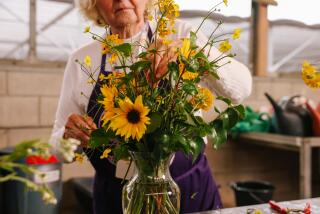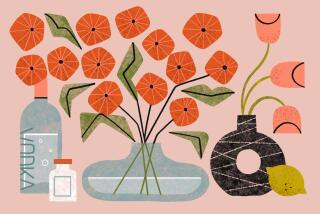GARDENING : Home Bouquets Just Depend on the Right Arrangements
- Share via
Most of us enjoy having bouquets of flowers and enjoy giving them when we visit friends. This spring, why not plan to grow bouquet flowers in your own garden? Here are some suggestions.
Marigolds and zinnias come in many varieties, are easy to grow and are fine in mass arrangements. Snapdragons and larkspur provide spiky flowers, and baby’s breath (gypsophila) and statice are light and airy. Others include aster, celosia, painted daisy, hollyhock and cornflower.
Steven A. Frowine, a horticulturist with the Burpee Seed Co., recommends choosing flower colors to go with your decor; to create a subtle arrangement, try soft pastels.
Plant in a well-drained spot that gets at least six hours of sunlight daily. Frowine uses simple garden techniques, planting flowers in the same pattern as vegetables--in straight single or double rows.
“I laid out a 15-foot by 30-foot area for my cut-flower garden,” Frowine said. “After I worked up the soil in the entire garden, I raked the loose soil into 10 raised beds 2 feet wide and 15 feet long, with a 12-inch aisle in between.”
He uses drip lines down the center of each bed, and mulches to eliminate bothersome weeds.
Tall flowers such as gladioluses, larkspur and snapdragons can use support to prevent them from being blown over by wind and rain. Wire fencing is easier to use than individual stakes. Flower heads will grow up through wire fencing laid horizontally.
Other suggestions:
* If you fertilize your cut flowers in the spring with a slow-release product, twice should be enough--once at planting time and again six to eight weeks later.
* To get the most blooms, be sure to cut them regularly. Don’t let them go to seed.
* Plant the taller varieties on the north side so they won’t shade the shorter varieties.
* Fragrant flowers, such as sweet peas, heliotrope, carnations and tuberose, will bring something more to the arrangement.
* You’ll have flowers earlier if you start some seeds indoors four to eight weeks before you should put them in the garden. Some annuals and perennials need a longer head start.
Larkspur and shirley poppies should not be started indoors because they do not transplant well, Frowine advised, adding that for ease in culture, “it is best to grow annuals and perennials in separate sections of the garden.”
He said that the way you harvest and handle your flowers can make quite a difference in how long they stay fresh.
Gather flowers in the morning or evening when they are stiff and fresh. Use clean, sharp pruners or knife. Bring a pail of clean, warm water with you into the garden and put the stems immediately into the water after cutting.
Indoors, put the cut flowers in a cool place for at least two hours to condition them before you arrange them. Use clean water in the final arrangement container. Strip off foliage from the portion of the stem that is submerged. “Adding a commercial flower preservative will further prolong the life of your flowers,” Frowine said.






